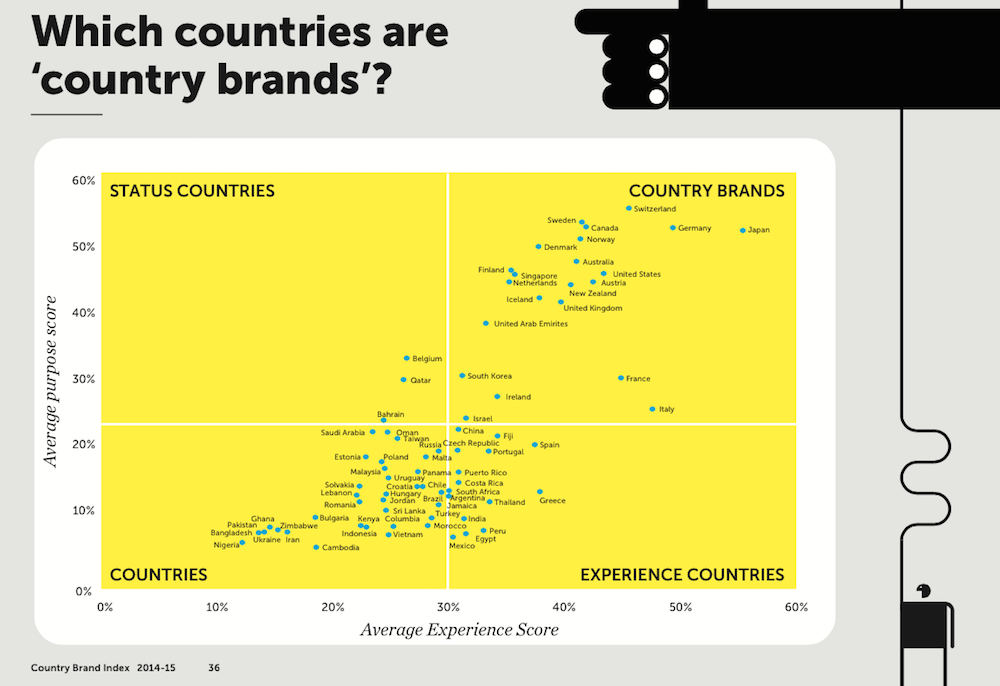This week the global brand consultancy FutureBrand, part of Interpublic Group, have released the sixth annual Country Brand Index 2014-2015 report that ranks 75 countries by seven perceptional dimensions, such as: awareness, familiarity, preference, associations, consideration, decision/visitation and advocacy; where the main factor—associations—is weighted across six more related attributes of status and experience (Value System, Quality of Life, Business Potential, Heritage and Culture, Tourism, and «Made In»).
The top five leaders of 2014-2015 ranking are Japan, Switzerland, Germany, Sweden and Canada with 17 more country brands to follow.

This year’s study is based on a complex mix of quantitative and qualitative data gathered from 2, 530 opinion leaders and frequent international business or leisure travelers from 17 countries: USA, Canada, Brazil, Argentina, Mexico, UK, Germany, France, Russia, Turkey, South Africa, UAE, India, China, Thailand, Japan and Australia.
In the previous five years, FutureBrand used to study and measure the strength of perception of 188 countries. In 2014-2015, the agency looks at 75 countries only, emphasizing the fact that only 22 of them qualify as «country brands».
So what makes a country brand?
Only those countries with «stronger than average» perception across six associational attributes from Value system to «Made In» can be qualified as country brands. FutureBrand admits that perception of a country as a desired place where people want to buy consumer products or services of high quality, where they want to travel to, live or study—these perceptions make a country brand.

Pic: Country brands, simply countries, status countries and experience countries are explained on the diagram
All the remaining countries are classified as:
- Simply “countries”—the ones that have below average perceptions in both the status and experience dimensions.
- “Status countries”—the ones whose perception strength is biased towards attributes relating to Value System, Quality Of Life and Business Potential. For example, Belgium, Qatar or Bahrain.
- “Experience countries”—the one whose perception strength is biased towards dimensions relating to Heritage & Culture, Tourism and Made In. For example, Spain, Greece, Thailand, Peru or Egypt.
The major takeaways from the FutureBrand Country Index 2014-2015 study:
1. Awareness alone doesn’t make a strong country brand. For example, awareness of Italy is higher than of Japan (89% vs 84%), however Italy ranks 17th, while Japan tops the chart.
2. The strength of country brand is connected to the number of well-known consumer brands produced or invented in the country. For example, Japan is known for such well-respected global brands as Toyota, Nintendo, Honda, Sony, Toshiba and Panasonic.
3. Strong country brands are associated with solid expertise in some consumer category. For example, France is associated with fashion (65%), Germany—with automobile industry (77%), and Japan—with technology (78%).
4. Strong country brands are leaders in technology, innovation and sustainability. The countries from the top-20 list succeed in these categories better than in geopolitics or other areas of domination.
5. A strong city brand doesn’t make a strong country brand. For example, Seoul, Mumbai or Rome are not on the list of the respective country brands, however, they are included in the top 20 most influential cities of the future, leaded by New York, London and Beijin.

Pic.: Top 20 influential cities, The Country Brand Index 2014-2015 by FutureBrand
Here’s what Tom Adams, Global Head of Strategy for FutureBrand Worldwide, comments on the Country Brands Index 2024-2015:
To learn the overall ranking of the 75 countries, rankings by dimension, complete perception dashboards for the top five country brands, regional leaders and averages and ‘ones to watch’ for the future—please download the full 55-page report here.